Three-Dimensional Outdoor Pedestrian Road Network Map Construction Based on Crowdsourced Trajectory Data
Abstract
1. Introduction
2. Methodology
2.1. Preprocessing of Outdoor Trajectory Data
- (a)
- Remove the trajectory points in the first minute and delete duplicate and redundant data.
- (b)
- Remove outliers and isolated trajectory points and segment the trajectory segments with abnormal distances or times. If the sampling distance or time between trajectory points is greater than a certain threshold, segment them.
- (c)
- Use the linear interpolation method for the trajectory points with sampling intervals that are too large to ensure the uniform spatial distribution of the trajectory points.
- (d)
- Use the trajectory data aggregation algorithm based on the gravity–repulsion force model [23] to aggregate the original trajectory data, gather the trajectory data towards the high-density central area, improve the spatial position accuracy of the original trajectory data, and ensure that the corrected trajectory points do not deviate from their original positions by more than the specified distance threshold. When performing trajectory aggregation, an extended gravity–repulsion force model is constructed to aggregate the trajectory points. In the model, the gravitational force from adjacent trajectory points will attract the source trajectory point towards the areas with higher density. In order to prevent the source trajectory point from deviating too much from its original position, a repulsive force is used to constrain the magnitude of the movement from its original position. The calculation formula for the gravitational force is as follows:The calculation formula for the repulsive force is as follows:where is the potential energy intensity, N is the number of trajectories, and are the variances, k is the spring constant, and t and are the offset distances from the road center and the original position, respectively. When conducting the experiments, we set the parameters , , , and k according to [23]. Specially, the potential energy intensity is set to 1; the variances is set to 5 m, and is set to 5 m as the standard deviation of the Gaussian distribution of the GPS error, and the spring constant is set to 0.005.
- (e)
- Use the high-precision DEM data with a spatial resolution of 12.5 m obtained by the Advanced Land Observing Satellite (ALOS) to perform the overall correction of the elevation information. Calculate the average value of the elevation differences between all trajectory points and the DEM (denoted as Ave). Delete the trajectory data with Ave greater than a certain threshold as abnormal data and correct the elevation of each trajectory point with Ave as the correction value for the remaining trajectory data. If the elevation difference between a certain trajectory point and the DEM data is greater than 10 m (the 10 m elevation correction threshold was determined based on the typical vertical positioning error (5–15 m) of consumer-grade GPS devices in obstructed outdoor environments) and the elevation differences between the two adjacent trajectory points and the DEM are small, mark it as an error point and replace the elevation of this trajectory point with the average value of the elevations of the two adjacent trajectory points. For the trajectory points with a difference from the DEM data of less than 10 m, update their elevations to the average of the elevations of the trajectory points and the DEM.
2.2. Identification of Intersections and Pedestrian Areas
- (a)
- On the road segment, the forward directions of the trajectory points are basically the same;
- (b)
- In the road intersection, the directions of the trajectory points are distributed in several main directions;
- (c)
- In the pedestrian area, due to the absence of specific road segments, the forward directions of the trajectories are relatively chaotic.
- (a)
- If the number of trajectory point clusters in a certain grid cell is one (one-way street) or two (two-way street), the average mean square error of the direction angles of the clusters is less than 20°, the number of trajectory points in each cluster is greater than , and the number of noise points is less than , then mark the grid as a road segment area.
- (b)
- If the number of trajectory point clusters in a certain grid cell is three or more (the intersection of multiple roads), the average mean square error of the direction angles of the clusters is less than 20°, the number of trajectory points in each cluster is greater than , and the number of noise points is less than , then mark the grid as a road intersection area.
- (c)
- In other cases, mark it as a pedestrian area, where is the number of trajectory points in the -th grid; the parameter is set to 0.15. Set the number of trajectory points in the minimum cluster to 4, and represents the floor function.
2.3. Hierarchical Extraction of the 3D Pedestrian Road Network Structure
- Identification of the scope of the road intersection: Based on the grid where the identified road intersection is located, further calculate the density center of the grid and merge the density centers within a certain distance threshold range. Use the minimum circumscribed circle of the grid center point as the estimation of the spatial scope of the road intersection. In the experiments of this paper, the distance threshold of the density center points is set to 5 m.
- Identification of intersection entrance and exit points: As shown in Figure 8, for the extraction of intersection entrance and exit points, first extract the trajectory data passing through the road intersection area and crop the trajectory through the boundary of the road intersection scope. Then, through a trajectory clustering method, such as the HDBSCAN-based trajectory clustering method [25], cluster the trajectories whose start and end points belong to the same road intersection into the same trajectory cluster. Calculate the intersection points of the trajectory cluster and the boundary of the road intersection scope and take the highest density point in the neighborhood as the plane position of the entrance and exit points of the road intersection. Take the average value of the elevation coordinates of a series of intersection points as the elevation value of the entrance and exit points.
- Extraction of 3D road centerline structures: Segment the trajectory data passing through the road intersection or pedestrian area. Then, use the trajectory clustering algorithm to extract the trajectory clusters between the road intersections or pedestrian areas. Finally, obtain the road centerline with curve fitting. In this paper, first pre-cluster the start and end points of the trajectory data. Then, screen the high-density trajectory clusters based on the Hausdorff distance and use the B-spline curve fitting method to fit the 3D road centerline from the screened trajectory clusters.
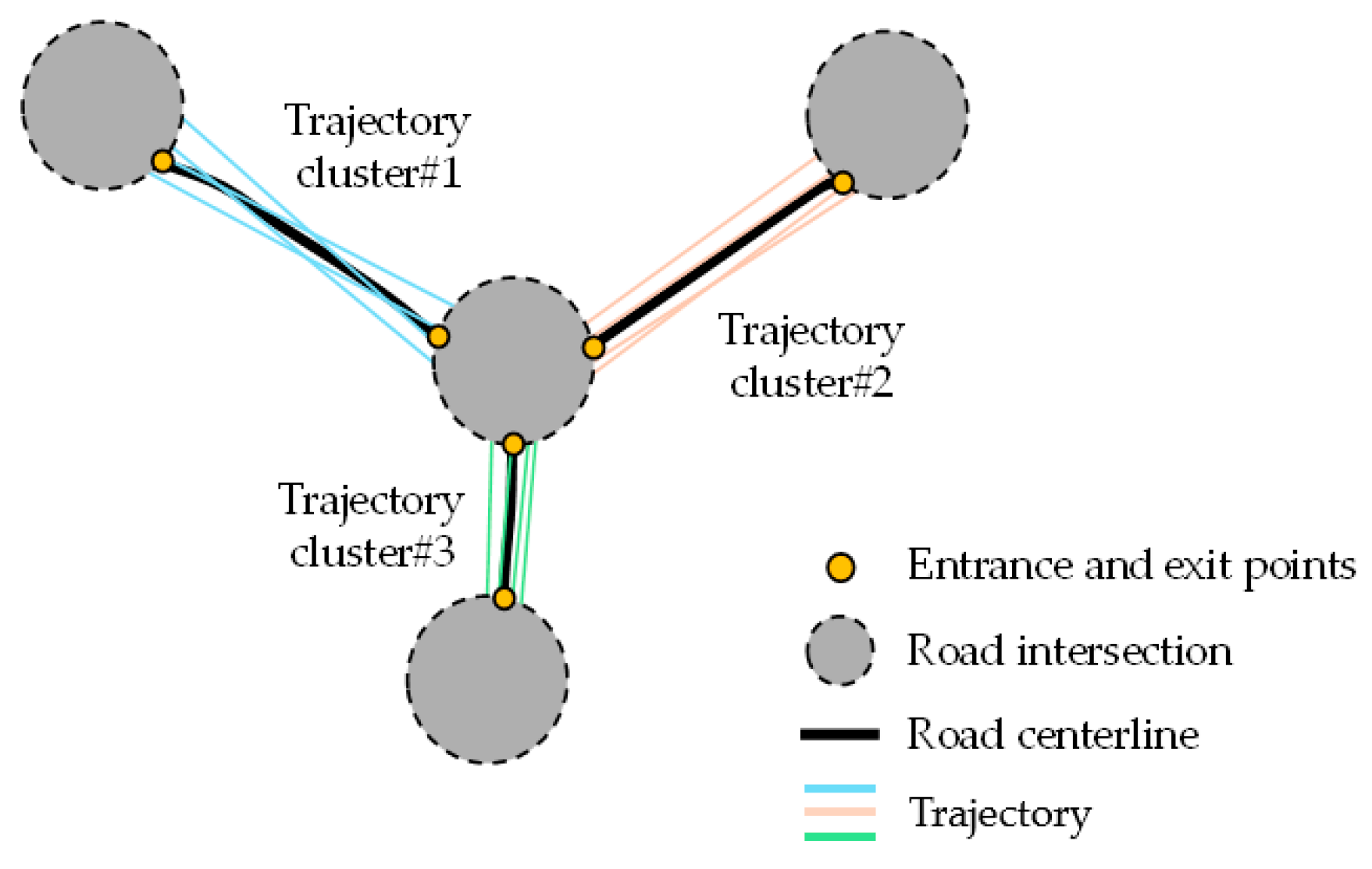
3. Experimental Analysis
3.1. Research Area and Experimental Data
3.2. Experimental Results and Analysis
3.3. Comparative Analysis
4. Conclusions
Author Contributions
Funding
Data Availability Statement
Conflicts of Interest
Abbreviations
| 3D | Three-Dimensional |
| 2D | Two-Dimensional |
| ALOS | Advanced Land Observing Satellite |
| DBSCAN | Density-Based Spatial Clustering of Applications with Noise |
| DEM | Digital Elevation Model |
| GPS | Global Positioning System |
| GIS | Geographic Information System |
| OSM | OpenStreetMap |
| RMSE | Root Mean Square Error |
References
- Ariffin, R.N.; Zahari, R.K. Perceptions of the Urban Walking Environments. Procedia-Soc. Behav. Sci. 2013, 105, 589–597. [Google Scholar] [CrossRef]
- Farkisch, H.; Ahmadi, V.; Che-Ani, A.I. Evaluation of neighborhood center attributes on resident’s territoriality and sense of belonging a case study in Boshrooyeh, Iran. Habitat Int. 2015, 49, 56–64. [Google Scholar] [CrossRef]
- Fonseca, F.P.; Ribeiro, P.J.; Jabbari, M.; Petrova, E.; Papageorgiou, G.; Conticelli, E.; Tondelli, S.; Ramos, R.A. Smart Pedestrian Network: An Integrated Conceptual Model for Improving Walkability. In Society with Future: Smart and Liveable Cities; Lecture Notes of the Institute for Computer Sciences, Social Informatics and Telecommunications Engineering; Springer: Cham, Switzerland, 2019; pp. 125–142. [Google Scholar]
- Kasemsuppakorn, P.; Karimi, H.A. A pedestrian network construction algorithm based on multiple GPS traces. Transp. Res. Part C Emerg. Technol. 2013, 26, 285–300. [Google Scholar] [CrossRef]
- Yang, X.; Tang, L.; Ren, C.; Chen, Y.; Xie, Z.; Li, Q. Pedestrian network generation based on crowdsourced tracking data. Int. J. Geogr. Inf. Sci. 2019, 34, 1051–1074. [Google Scholar] [CrossRef]
- Weston, R.; Mota, J.C. Low Carbon Tourism Travel: Cycling, Walking and Trails. Tour. Plan. Dev. 2012, 9, 1–3. [Google Scholar] [CrossRef]
- Jabbari, M.; Fonseca, F.; Smith, G.; Conticelli, E.; Tondelli, S.; Ribeiro, P.; Ahmadi, Z.; Papageorgiou, G.N.; Ramos, R. The Pedestrian Network Concept: A Systematic Literature Review. J. Urban Mobil. 2023, 3, 100051. [Google Scholar] [CrossRef]
- Deng, M.; Luo, B.; Tang, J.B.; Yao, Z.P.; Liu, G.P.; Wen, X.; Hu, R.B.; Chai, H.; Hu, W.K. Extracting road intersections from vehicle trajectory data in the face of trace density disparity. Acta Geod. Cartogr. Sin. 2023, 52, 1000–1009. [Google Scholar]
- Zhang, C.L.; Xiang, L.G.; Li, Y.L.; Wang, W.L. Construction of navigable road network based on taxi trajectories. Acta Geod. Cartogr. Sin. 2021, 50, 1650. [Google Scholar]
- Ahmed, M.; Karagiorgou, S.; Pfoser, D.; Wenk, C. A comparison and evaluation of map construction algorithms using vehicle tracking data. Geoinformatica 2015, 19, 601–632. [Google Scholar] [CrossRef]
- Agamennoni, G.; Nieto, J.I.; Nebot, E.M. Robust Inference of Principal Road Paths for Intelligent Transportation Systems. IEEE Trans. Intell. Transp. Syst. 2011, 12, 298–308. [Google Scholar] [CrossRef]
- Edelkamp, S.; Schrodl, S. Route planning and map inference with global positioning traces. In Computer Science in Perspective; Springer: New York, NY, USA, 2003; Volume 2598, pp. 128–151. [Google Scholar]
- Shi, W.; Shen, S.; Liu, Y. Automatic generation of road network map from massive GPS, vehicle trajectories. In Proceedings of the 12th International IEEE Conference on Intelligent Transportation Systems, St. Louis, MO, USA, 4–7 October 2009; pp. 1–6. [Google Scholar]
- Huang, J.C.; Deng, M.; Zhang, Y.F.; Liu, H.M. Complex road intersection modelling based on low-frequency GPS track data. Int. Arch. Photogramm. 2017, XLII-2/W7, 23–29. [Google Scholar] [CrossRef]
- Deng, M.; Huang, J.C.; Zhang, Y.F.; Liu, H.M.; Tang, L.L.; Tang, J.B.; Yang, X. Generating urban road intersection models from low-frequency GPS trajectory data. Int. J. Geogr. Inf. Sci. 2018, 32, 2337–2361. [Google Scholar] [CrossRef]
- Wan, Z.J.; Li, L.Y.; Yang, M.; Zhou, X.D. Decision tree model for extracting road intersection feature from vehicle trajectory data. Acta Geod. Cartogr. Sin. 2019, 48, 1391–1403. [Google Scholar]
- Yao, Z.P.; Peng, C.; Tang, J.B.; Liu, G.P.; Yang, X.X.; Liu, H.M.; Deng, M. An adaptive road centerline extraction method for different trajectory data scenarios based on combinatorial optimization. Acta Geod. Cartogr. Sin. 2024, 53, 379–390. [Google Scholar]
- Ahmed, M.; Wenk, C. Constructing street networks from GPS trajectories. In Proceedings of the European Symposium on Algorithms, Ljubljana, Slovenia, 10–12 September 2012; pp. 60–71. [Google Scholar]
- He, S.; Bastani, F.; Abbar, S.; Alizadeh, M.; Balakrishnan, H.; Chawla, S.; Madden, S. RoadRunner: Improving the precision of road network inference from GPS trajectories. In Proceedings of the 26th ACM SIGSPATIAL International Conference on Advances in Geographic Information Systems (SIGSPATIAL ’18), Seattle, WA, USA, 6–9 November 2018; Association for Computing Machinery: New York, NY, USA, 2018; pp. 3–12. [Google Scholar]
- Zhao, Y.; Wang, G.; Yang, J.; Li, T.; Li, Z. AU3-GAN: A Method for Extracting Roads from Historical Maps Based on an Attention Generative Adversarial Network. J. Geovisualization Spat. Anal. 2024, 8, 26. [Google Scholar] [CrossRef]
- Xu, Y.; Shi, Z.; Xie, X.; Chen, Z.; Xie, Z. Residual Channel Attention Fusion Network for Road Extraction Based on Remote Sensing Images and GPS Trajectories. IEEE J. Sel. Top. Appl. Earth Obs. Remote Sens. 2024, 17, 8358–8369. [Google Scholar] [CrossRef]
- Wang, H.; Wu, Y.; Han, X.; Xu, M.L.; Chen, W.Z. Automatic generation of large-scale 3D road networks based on GIS data. Comput. Graph. 2021, 96, 71–81. [Google Scholar] [CrossRef]
- Cao, L.; Krumm, J. From GPS traces to a routable road map. In Proceedings of the 17th ACM SIGSPATIAL International Conference on Advances in Geographic Information Systems, Seattle, WA, USA, 4–6 November 2009; pp. 3–12. [Google Scholar]
- Ester, M.; Kriegel, H.-P.; Sander, J.; Xu, X. A Density-Based Algorithm for Discovering Clusters in Large Spatial Databases with Noise; Institute for Computer Science, University of Munich: Munich, Germany, 1996; pp. 226–231. [Google Scholar]
- Adrián, H.C.; Zanón, B.B.; Alfonso, S.P.; Doležel, P. Comparison of Geospatial Trajectory Clustering and Feature Trajectory Clustering for Public Transportation Trip Data. In Hybrid Artificial Intelligence Systems; Springer: Cham, Switzerland, 2023; pp. 60–71. [Google Scholar]
- Lyu, H.; Pfoser, D.; Sheng, Y. Movement-aware map construction. Int. J. Geogr. Inf. Sci. 2021, 35, 1065–1093. [Google Scholar] [CrossRef]
- Biagioni, J.; Eriksson, J. Map inference in the face of noise and disparity. In Proceedings of the ACM 20th International Conference on Advances in Geographic Information Systems, Redondo Beach, CA, USA, 6–9 November 2012; pp. 79–88. [Google Scholar]
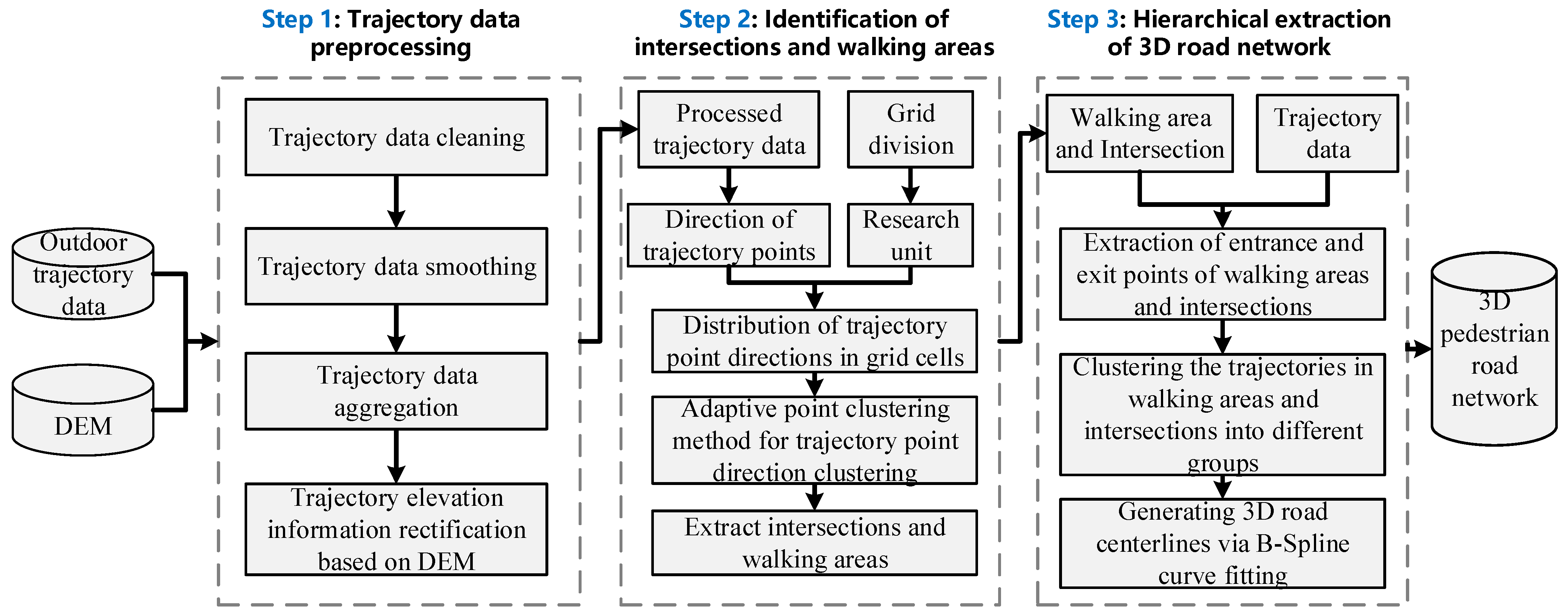
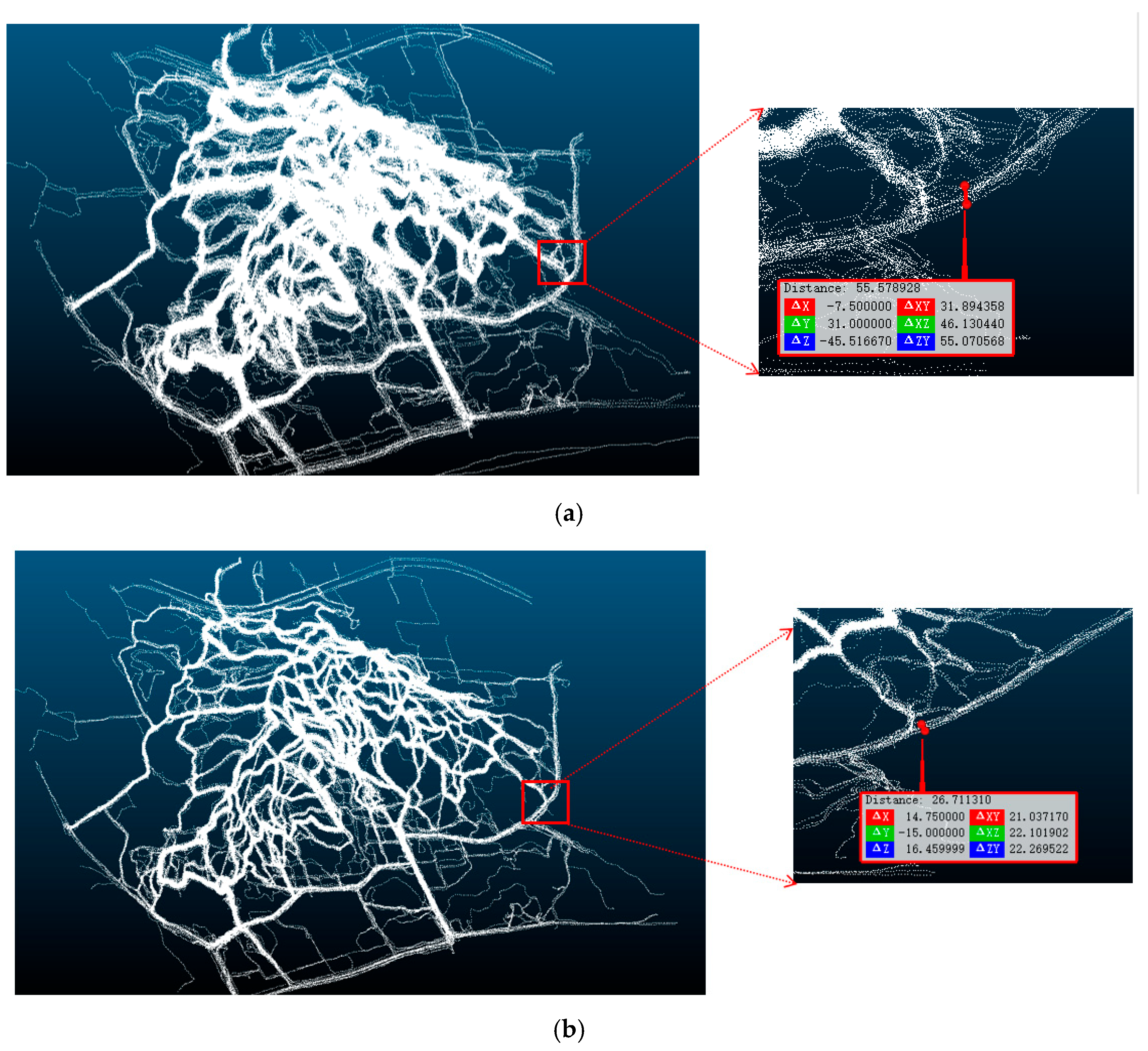
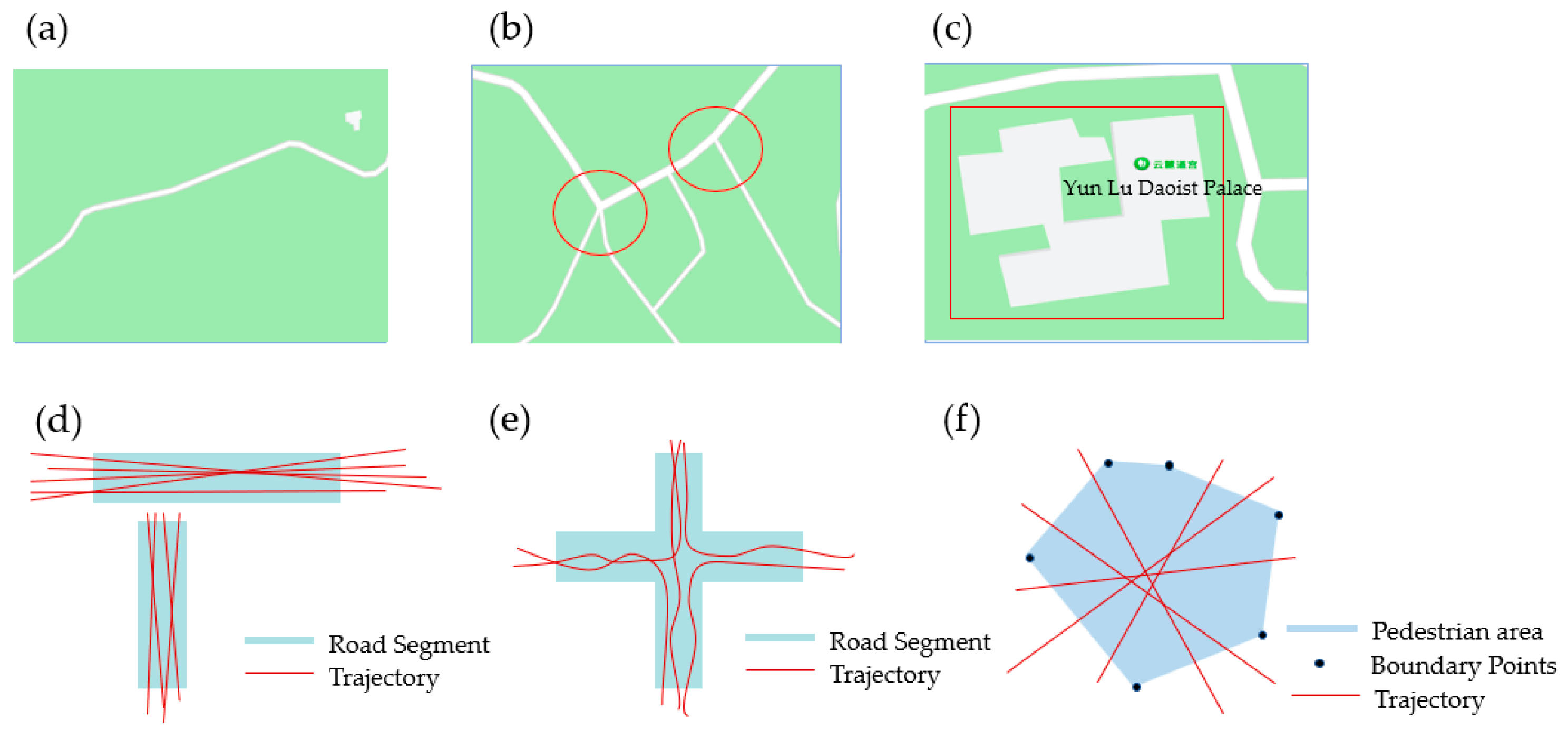
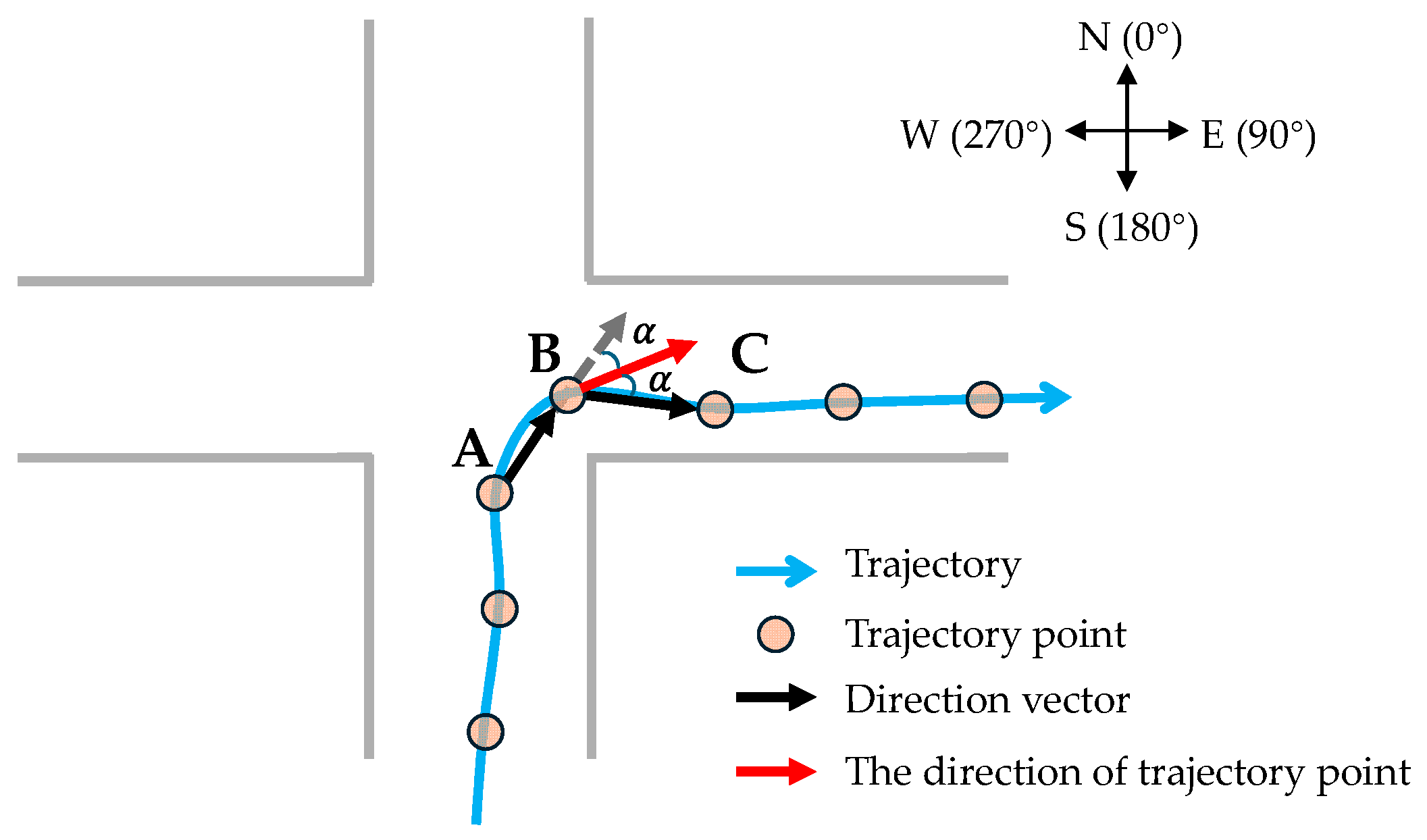
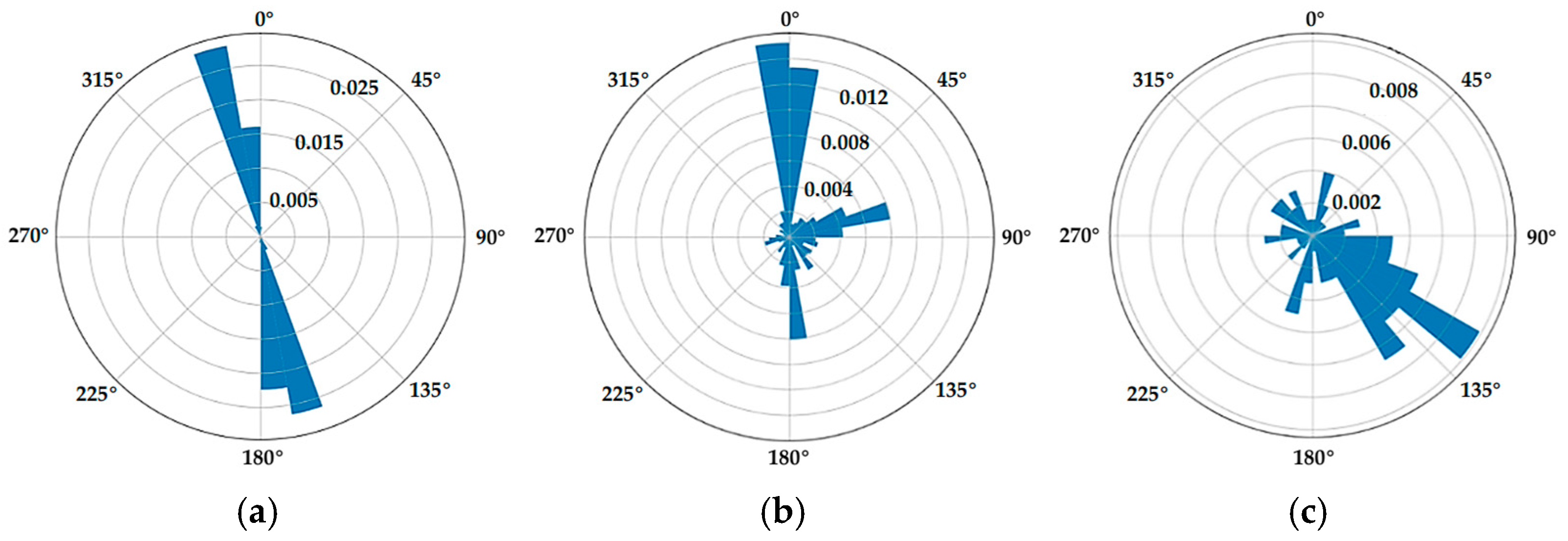

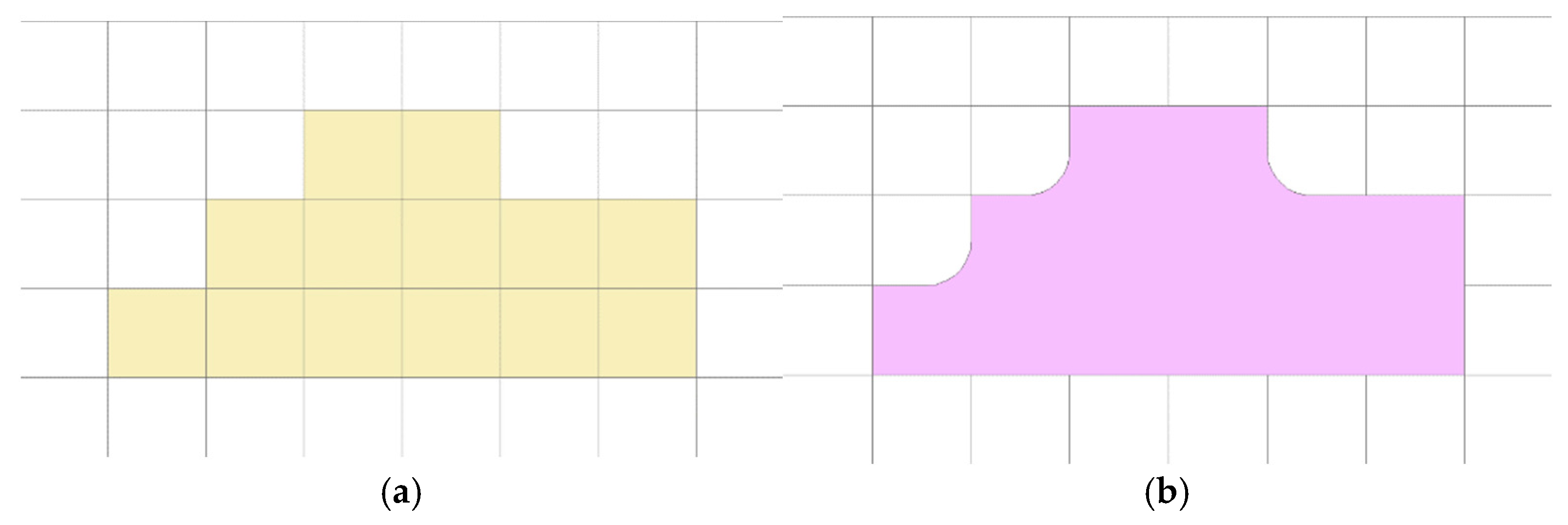
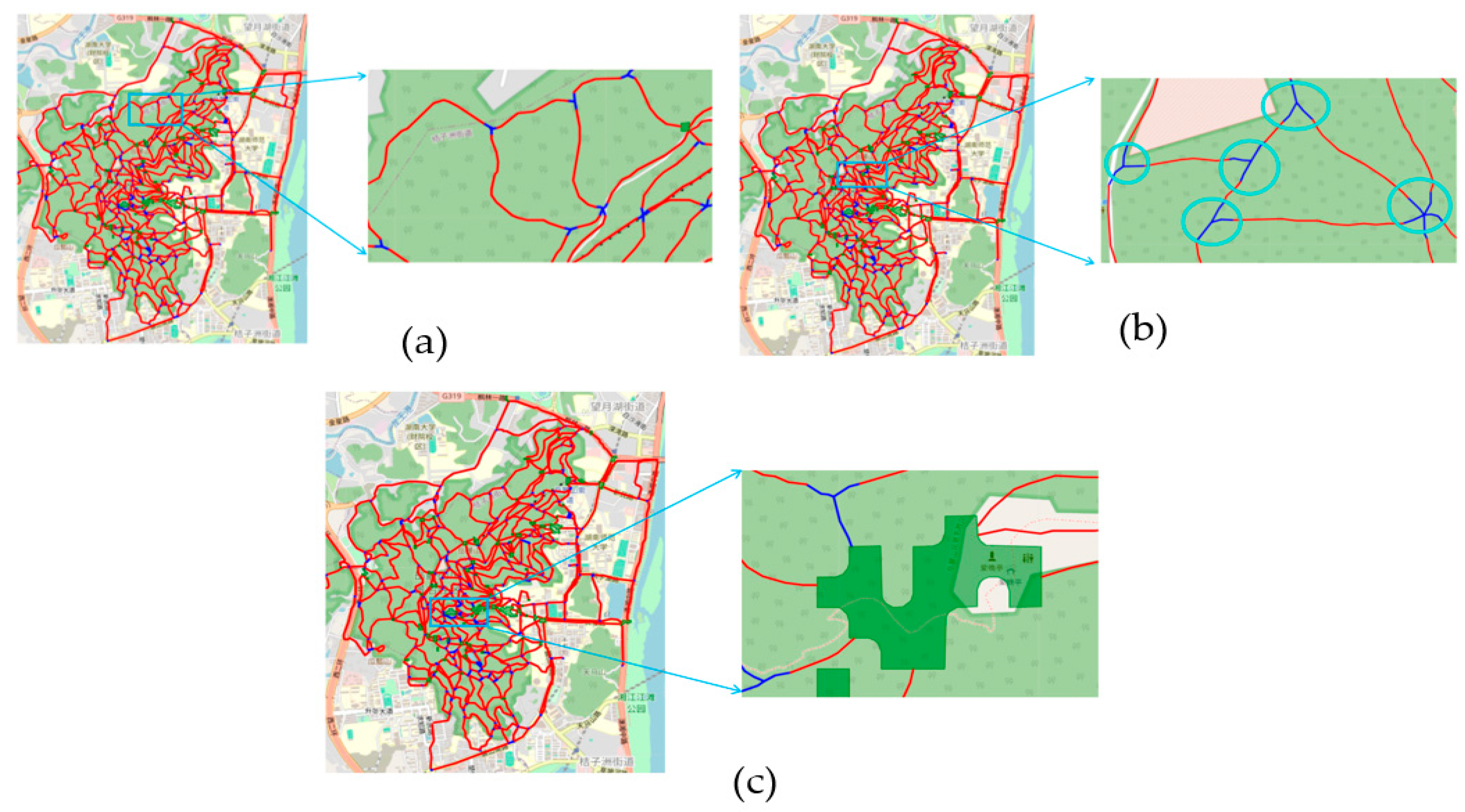
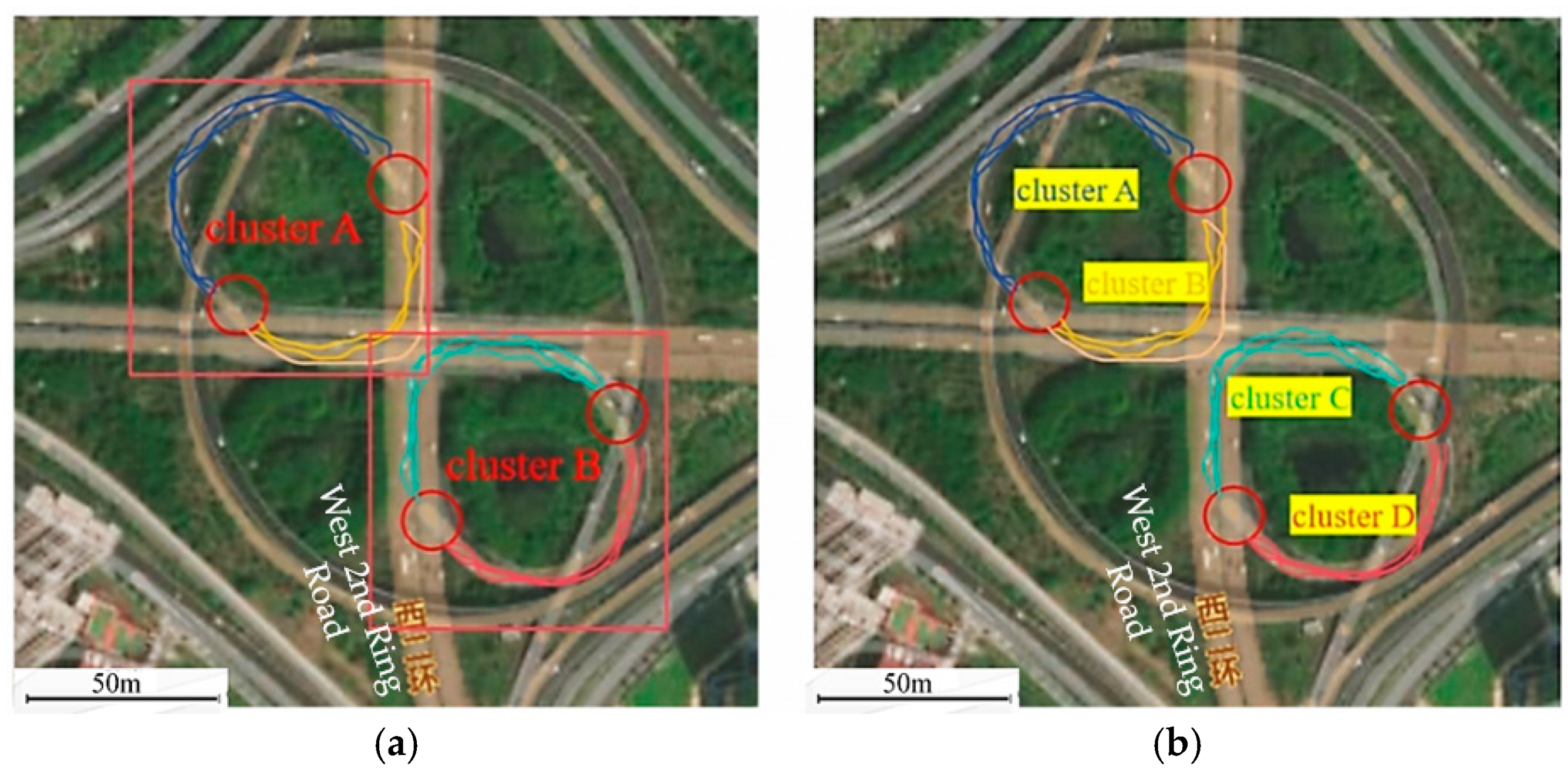

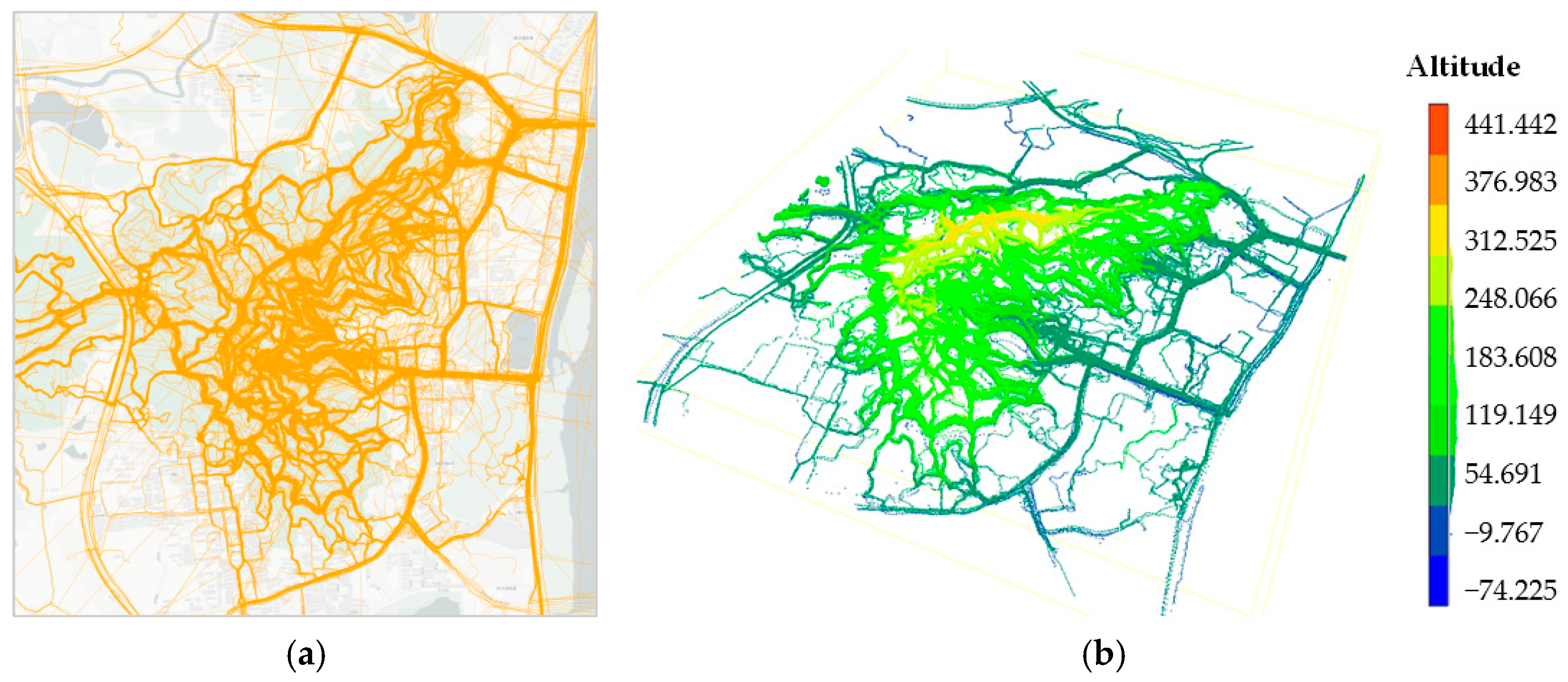

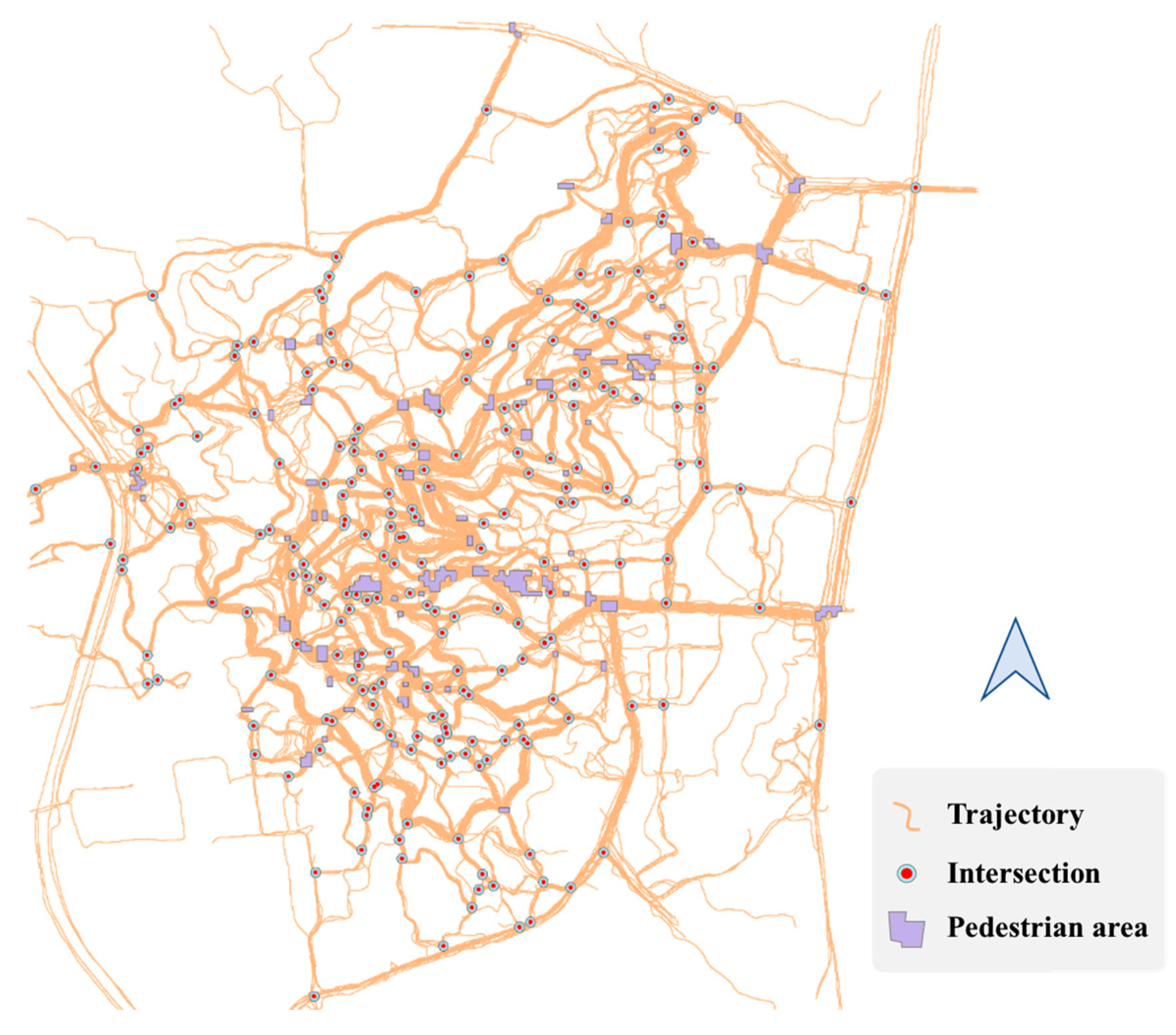
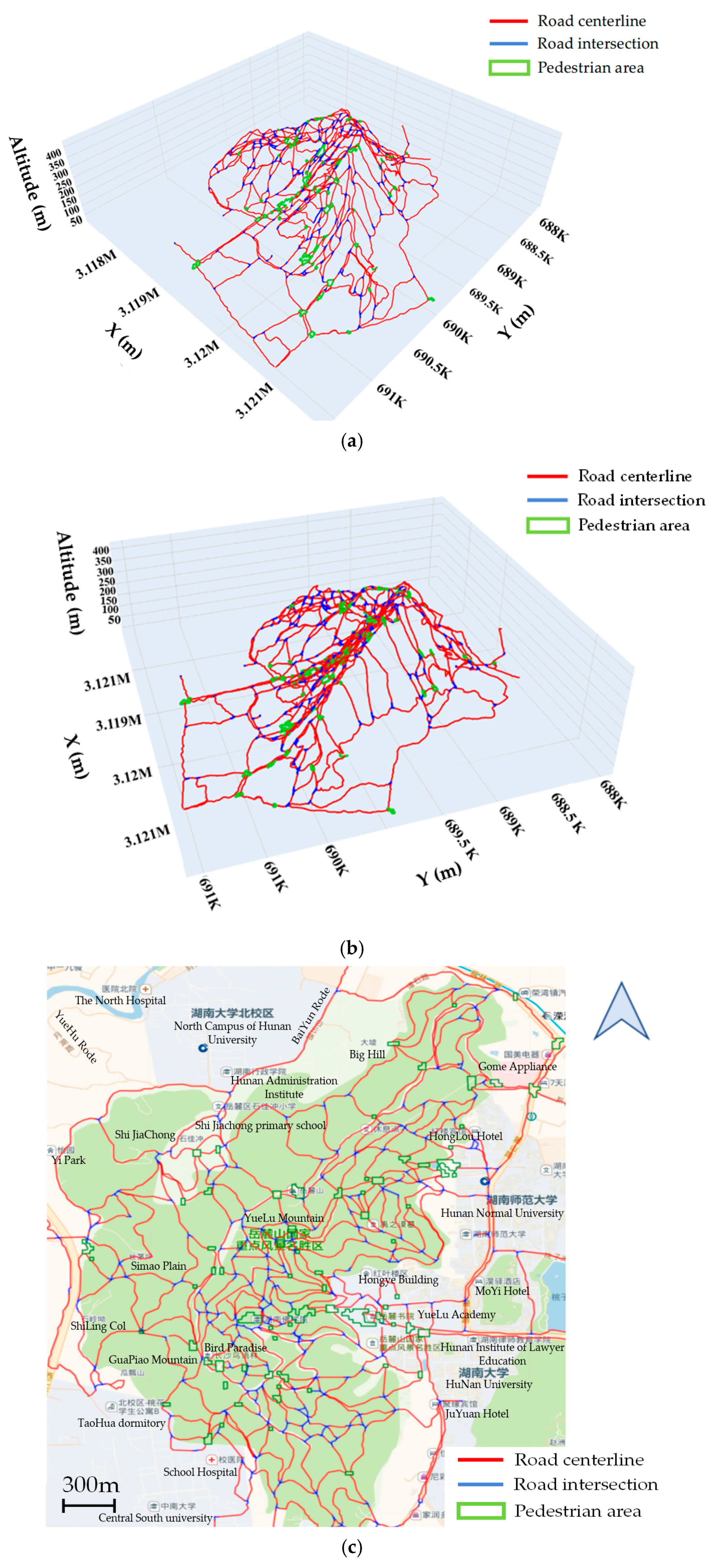

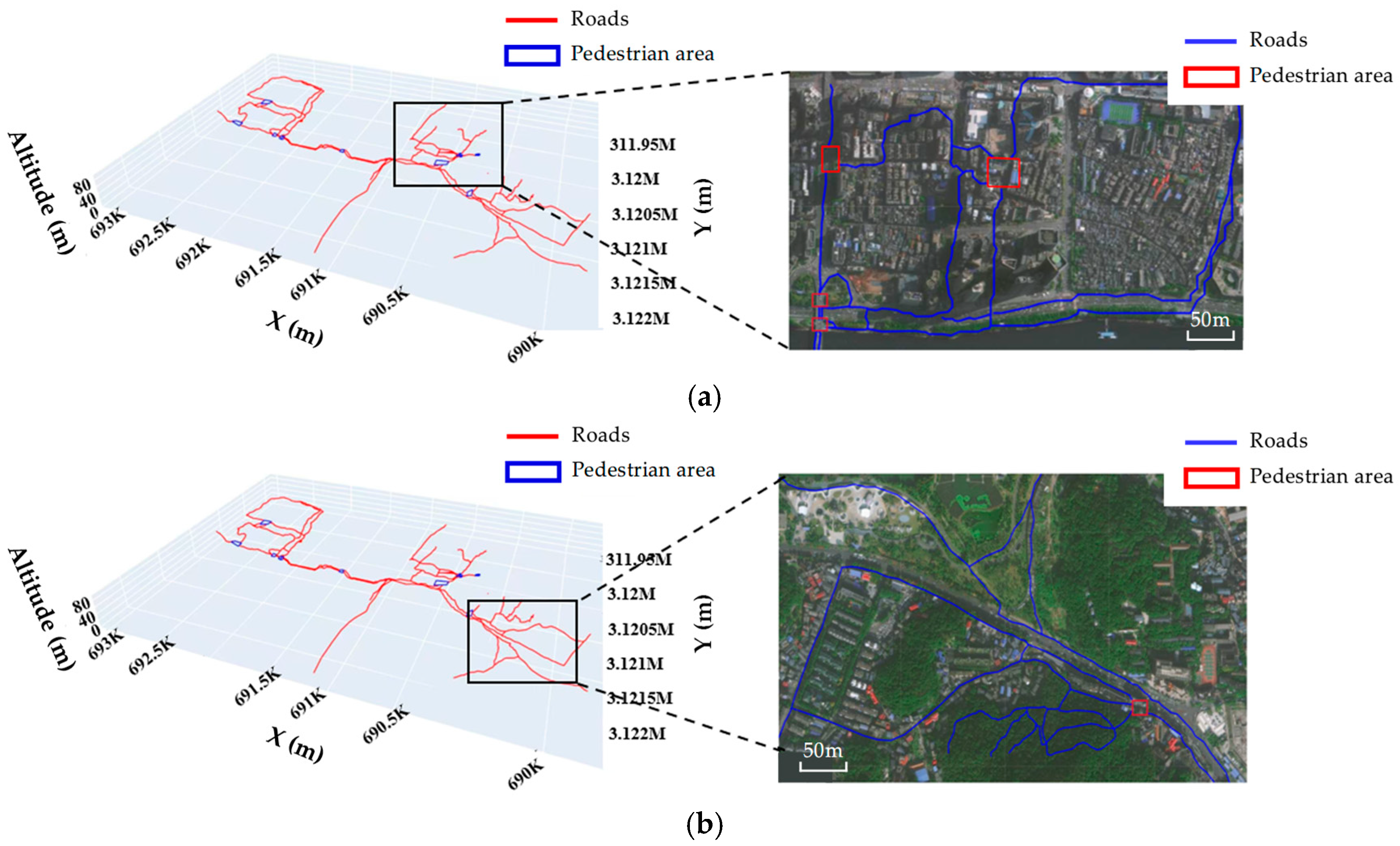
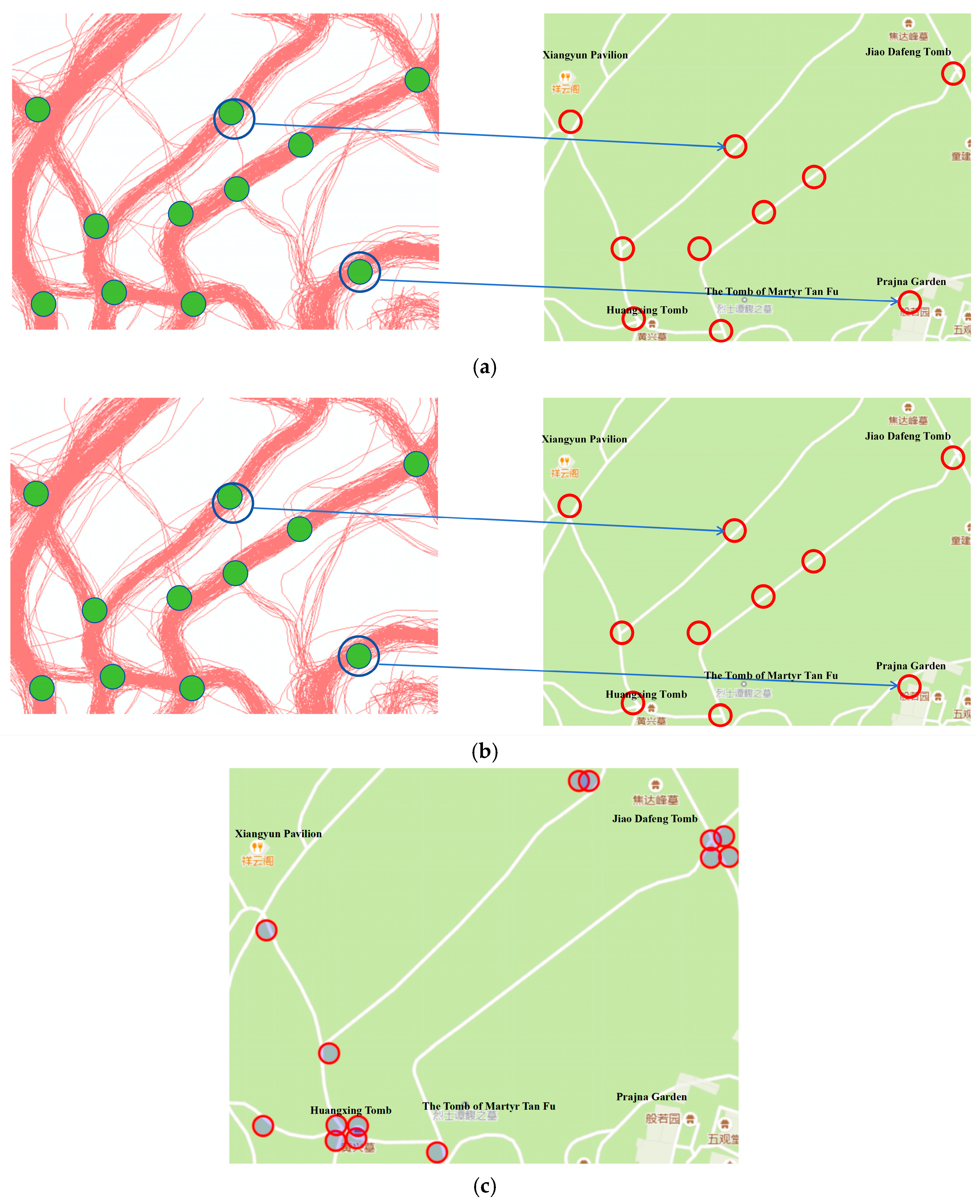
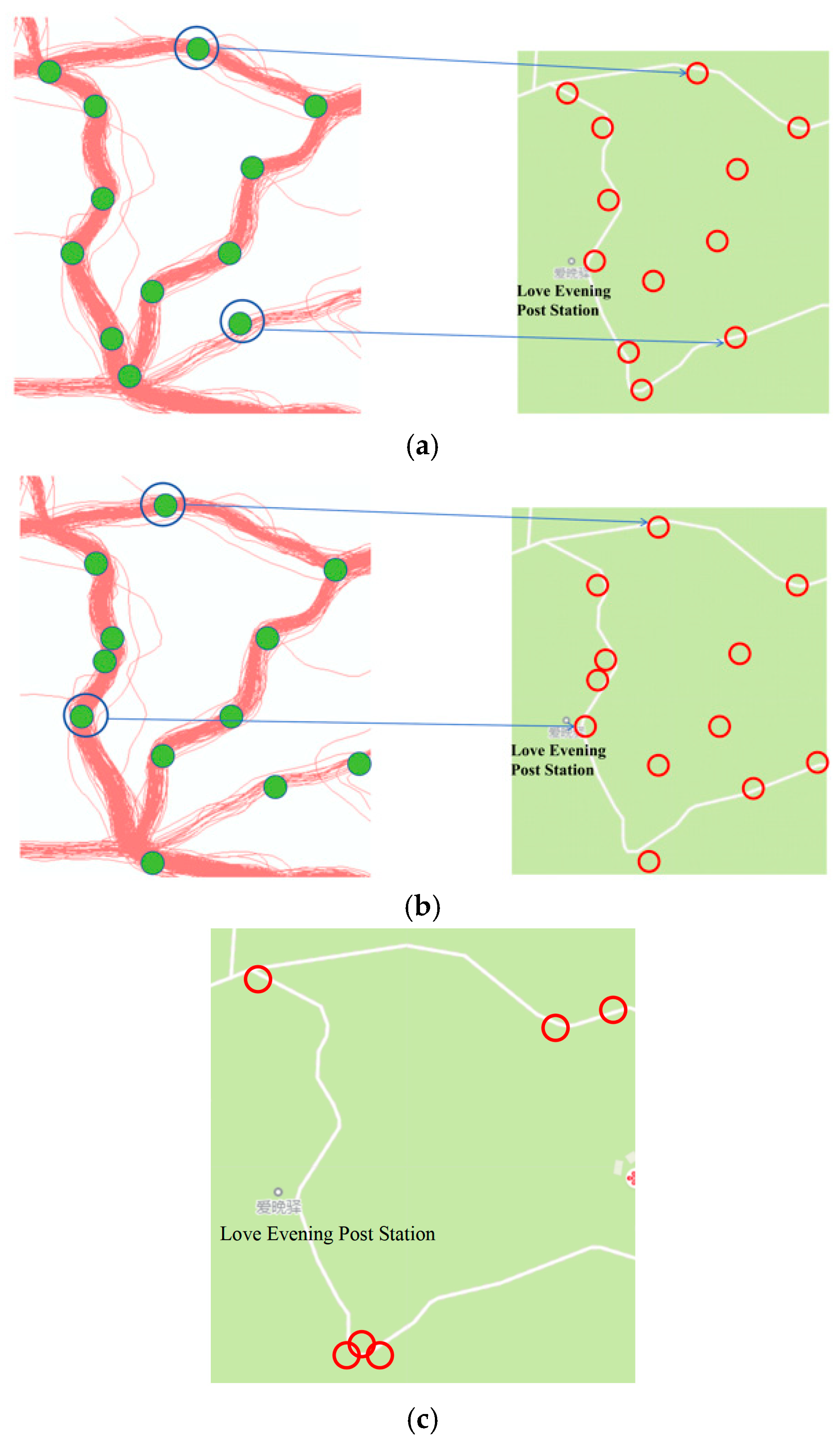

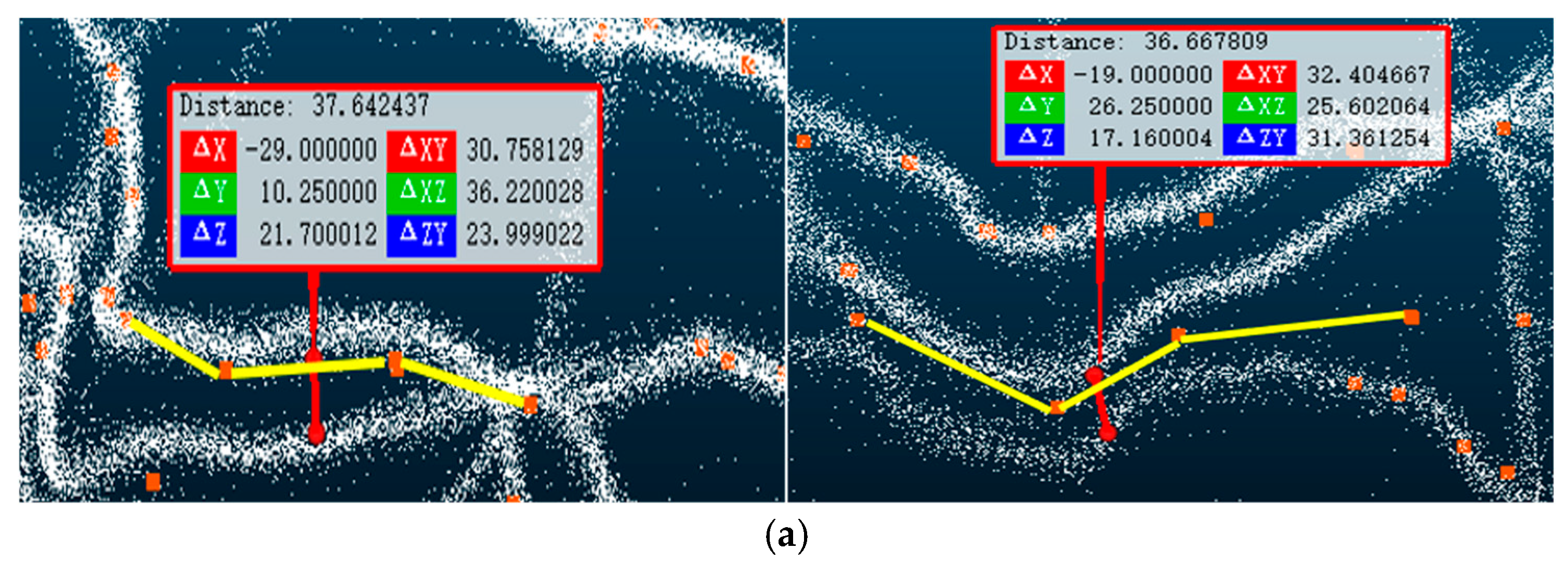
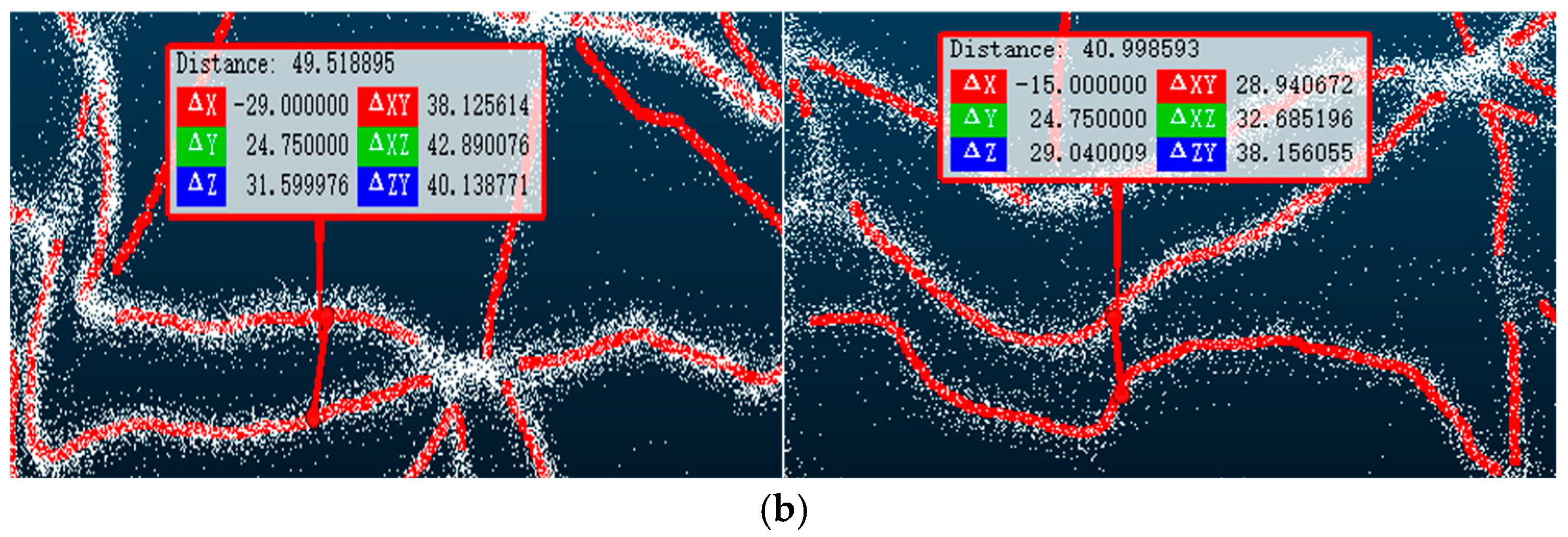
| Method | Precision | Recall | F1 |
|---|---|---|---|
| KDE | 46.8% | 74.2% | 0.574 |
| MAMC | 63.4% | 79.4% | 0.705 |
| Ours | 92.2% | 67.8% | 0.781 |
Disclaimer/Publisher’s Note: The statements, opinions and data contained in all publications are solely those of the individual author(s) and contributor(s) and not of MDPI and/or the editor(s). MDPI and/or the editor(s) disclaim responsibility for any injury to people or property resulting from any ideas, methods, instructions or products referred to in the content. |
© 2025 by the authors. Published by MDPI on behalf of the International Society for Photogrammetry and Remote Sensing. Licensee MDPI, Basel, Switzerland. This article is an open access article distributed under the terms and conditions of the Creative Commons Attribution (CC BY) license (https://creativecommons.org/licenses/by/4.0/).
Share and Cite
Tang, J.; Zhang, T.; Ding, J.; Tao, K.; Yang, C.; Xiang, J.; Ning, X. Three-Dimensional Outdoor Pedestrian Road Network Map Construction Based on Crowdsourced Trajectory Data. ISPRS Int. J. Geo-Inf. 2025, 14, 175. https://doi.org/10.3390/ijgi14040175
Tang J, Zhang T, Ding J, Tao K, Yang C, Xiang J, Ning X. Three-Dimensional Outdoor Pedestrian Road Network Map Construction Based on Crowdsourced Trajectory Data. ISPRS International Journal of Geo-Information. 2025; 14(4):175. https://doi.org/10.3390/ijgi14040175
Chicago/Turabian StyleTang, Jianbo, Tianyu Zhang, Junjie Ding, Ke Tao, Chen Yang, Jianbing Xiang, and Xia Ning. 2025. "Three-Dimensional Outdoor Pedestrian Road Network Map Construction Based on Crowdsourced Trajectory Data" ISPRS International Journal of Geo-Information 14, no. 4: 175. https://doi.org/10.3390/ijgi14040175
APA StyleTang, J., Zhang, T., Ding, J., Tao, K., Yang, C., Xiang, J., & Ning, X. (2025). Three-Dimensional Outdoor Pedestrian Road Network Map Construction Based on Crowdsourced Trajectory Data. ISPRS International Journal of Geo-Information, 14(4), 175. https://doi.org/10.3390/ijgi14040175







